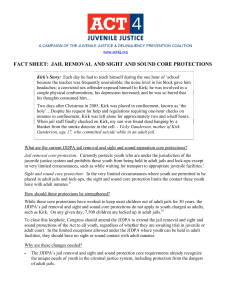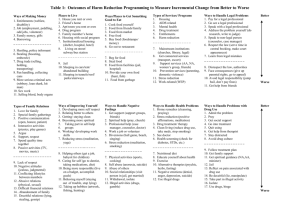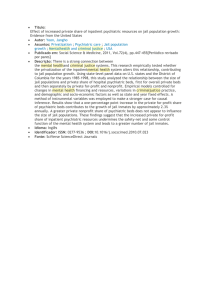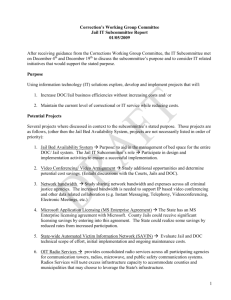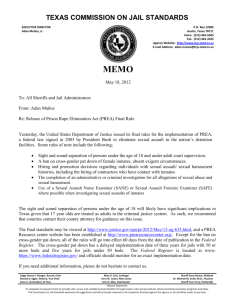Implementing Organizational Change in Criminal Justice: Some
advertisement
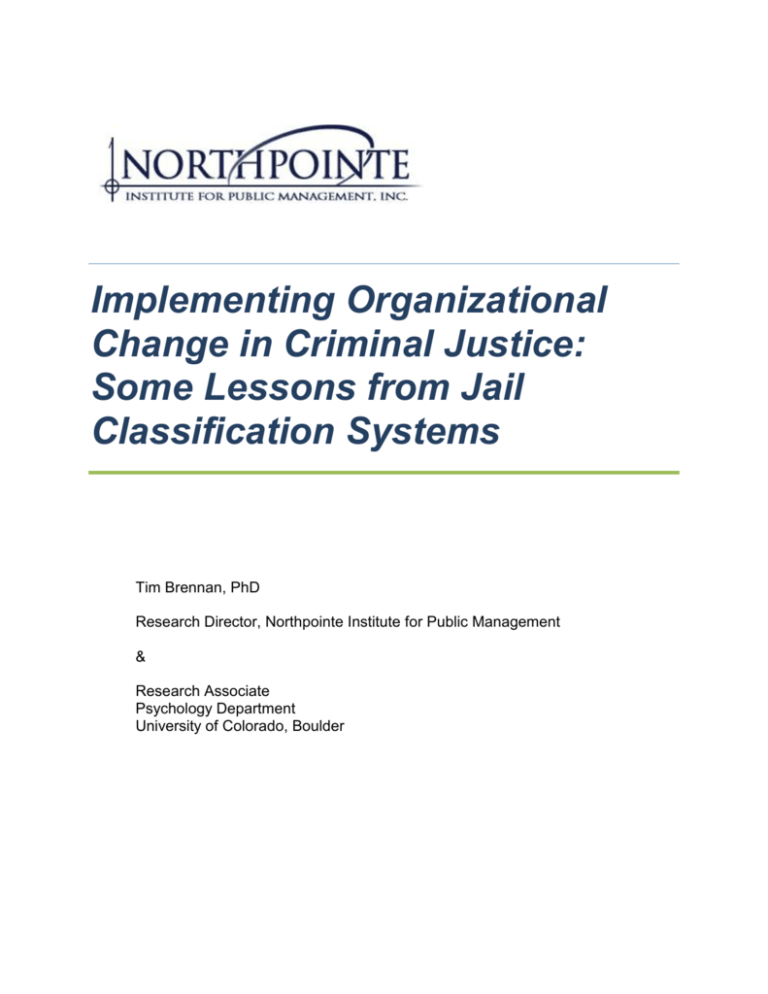
Implementing Organizational Change in Criminal Justice: Some Lessons from Jail Classification Systems Tim Brennan, PhD Research Director, Northpointe Institute for Public Management & Research Associate Psychology Department University of Colorado, Boulder Abstract This paper examines the underlying processes involved in implementing complex change in criminal justice. Such changes may include the implementation of new policies, procedures, information technology, or new programs. A large scale technical assistance program to help jails implement objective classification provided a series of long term case studies of the implementation process. A four-stage model of the implementation process developed during this project is described. This aimed to help jail managers and other criminal justice leaders conceptualize the process of implementation and it's sub-components. Nineteen specific factors are described which critically influence the success of these implementation efforts. Key Words: Implementation models, Change management, Objective classification, Jail classification, Change strategies Northpointe – Evolving Practice Through Scientific Innovation 2 Table of Contents Abstract ................................................................................................................................................. 2 Introduction ........................................................................................................................................... 4 Background of Objective Jail Classification Systems .................................................................... 5 Classification within the Jail ............................................................................................................... 7 The Difficulty of Implementing Change in Criminal Justice ...................................................... 9 The Importance of Implementation Skills .................................................................................. 10 A Sequential Model for the Implementation Process ............................................................... 11 Phase 1: Pre-Implementation .................................................................................................. 12 Phase 2: Design: Preliminary Testing, Validation, and Evaluation .................................... 15 Phase 3: Implementation (Going Live!) .................................................................................. 17 Phase 4: Post-Implementation ................................................................................................ 19 Identifying Key Factors and Critical Problems for Successful Implementation. ...................... 21 Factors Related to the "Content" of the Innovation .................................................................. 22 Factors within the Organizational Context ................................................................................. 23 Factors Related to the Implementation Process ...................................................................... 26 Factors Related to the Agency’s External Environment .......................................................... 28 Bibliography ........................................................................................................................................ 31 Northpointe – Evolving Practice Through Scientific Innovation 3 Introduction This paper examines the processes underlying the implementation of complex procedural or policy change in criminal justice agencies. For the past two decades rapid change, as opposed to procedural stability, has been the rule rather than the exception in criminal justice agencies. During this time we have witnessed profound changes in the philosophy of corrections, in sentencing models, in program designs, and in the introduction of information technologies. Criminal justice managers face an intense challenge to develop skills in managing the implementation of new policies, programs and procedures. This paper uses the introduction of new objective classification procedures into jails as a basis to examine implementation strategies. In the area of classification and risk assessment criminal justice agencies have faced several sources of pressure to change or update their procedures. First, new developments in risk assessment and classification methods have been a 1-3 major source of pressure to innovate. Second, new legislation or litigation has forced many agencies to upgrade their assessment and classification procedures.4 Litigation by prisoners and their advocates generally focuses on the weaknesses, inconsistency, or unfairness of current classification methods. Developments in information technology have also created a need for upgraded classification procedures. A first goal of this paper is to present a systematic model of implementation based on a large number of jail case studies conducted over a 10-year period. A second goal is to clarify the major practical lessons regarding success or failure of these implementation efforts. The case studies were part of a major national project in which new objective classification systems were being implemented in jails. The project has been supported by the National Institute of Corrections 9-11 (NIC) to help jails implement objective classification techniques. Over the history of this project NIC has provided regular management training seminars and ongoing technical assistance to over 150 jails. The aim is not to provide detailed descriptions of case studies, but to clarify more general lessons learned from these jail projects and to describe a generalized model of implementation that integrates the findings from these case studies with the fairly sparse literature on criminal justice implementation. This generalized model may provide jail administrators and other criminal justice managers with Northpointe – Evolving Practice Through Scientific Innovation 4 an understanding of the sequential phases, tasks, and challenges when managing complex change. The model aims to clarify the many management actions, tasks, and staff roles needed at key phases of implementation. The development of this general model of implementation was influenced both by the field experiences in these jails and by several prior models of strategic change: the strategic approach of Pettigrew et al.; 5 Walton's process framework;6 the 7 8 work of Harris and Smith and Ellickson and Petersilia in criminal justice implementation; and Bushe and Shani (1991) in clarifying "learning capacity" of an organization. Several key questions emerged from these jail case studies. Each question was critical to success as each jail attempted to implement the new classification procedures. 1. What key skills are needed, and at what stages, by jail managers? 2. What are the relevant roles of leaders, change agents, implementation teams, and other personnel in managing change? 3. What explains the significant variation between jails given that a highly similar implementation task, with similar classification technologies was being addressed by each jail? Why did the speed and integrity of implementation vary so widely when the same issue was addressed at each jail? 4. Can a general model of implementation be used across agencies, and when different projects are implemented, or must each agency adopt a unique strategy? Background of Objective Jail Classification Systems The history of inmate classification in the United States closely parallels the evolution of the nation's correctional philosophy. Before 1870, when corrections focused on retribution and punishment, classification was based primarily on type of offense. Inmates were classified for the purpose of determining the "appropriate" punishment. There was no need to extend the process further because all inmates were housed in comparable settings and occupied their time in a similar manner. In the latter part of the nineteenth century, however, corrections changed direction: Reform and rehabilitation were introduced as important goals. As these goals gained prominence and acceptance, classification began to ground Northpointe – Evolving Practice Through Scientific Innovation 5 itself in clinical diagnostic categories that emphasized offenders’ "personal pathologies." Inmates, because they had been arrested and convicted, were assumed to be deficient in personal growth and survival skills. The task of classification was to identify such deficiencies so that they could be corrected. Use of this medical model of classification proliferated during much of the twentieth century as the psychological and sociological causes of crime were explored and as methods for assessing offenders grew more sophisticated. This trend continued into the early 1970s. At that time it began to lose favor because of public frustration with rising crime rates, gratuitous violence, and perceived failure of treatmentoriented programs. Today, corrections in many jurisdictions is based increasingly on a retributive (punishment) or "just desserts" philosophy of handling offenders. Previous assumptions about the efficacy of rehabilitation have been challenged. Litigation has also increased in regard to inappropriate use of criteria for determining how inmates are housed, and when and whether they are permitted to participate in correctional programs. These developments, along with the well-publicized national jail crowding crisis, have affected traditional classification strategies governing the management of inmates. Correctional classification systems have been moving from so-called "subjective" models to "objective" systems. Subjective models tend to rely on informal criteria, which often lead to inconsistency and error in staff members’ decision making. Conversely, objective systems depend on a narrow set of well-defined legal criteria (e.g., severity of current offense, prior arrests) and personal characteristics such as age and marital status. These items are weighted and assigned differential values (points) on a well-defined instrument, which then is used to assess an inmate's level of risk or program needs. Objective systems place greater emphasis on fairness, consistency, and openness in the decisionmaking process. In 1973 the National Advisory Committee on Criminal Justice Standards and Goals outlined standards for inmate classification. More recently, as a result of the increasing emphasis on classification as a management tool and the growing pressure to improve classification, considerable attention has been focused on the process of classification. Many individuals and organizations have provided guidance in structuring effective procedures. Among the most widely accepted guidelines are the 14 principles formulated by Solomon (1980) and subsequently adopted by the National Institute of Corrections (NIC): Northpointe – Evolving Practice Through Scientific Innovation 6 1. There must be a clear definition of goals and objectives of the total correctional system. 2. There must be detailed written procedures and policies governing the classification process. 3. The classification process must provide for the collection of complete, high-quality, verified, standardized data. 4. Measurement and testing instruments used in the classification decisionmaking process must be valid, reliable, and objective. 5. There must be explicit policy statements structuring and checking the discretionary decision-making powers of the classification team staff. 6. There must be provision for screening and further evaluating prisoners who present management problems and those who have special needs. 7. There must be provisions to match offenders with programs; these provisions must be consistent with custody classification. 8. There must be provisions to classify prisoners at the least restrictive custody level. 9. There must be provisions to involve prisoners in the classification process. 10. There must be provisions for systematic, periodic reclassification hearings. 11. The classification process must be efficient and economically sound. 12. There must be provisions to continuously evaluate and improve the classification process. 13. Classification procedures must be consistent with constitutional requisites. 14. There must be an opportunity for input from administration and line staff when undertaking development of a classification system. Classification within the Jail Northpointe – Evolving Practice Through Scientific Innovation 7 The history of inmate classification deals primarily with classification in prisons; the use of classification in jails is relatively new. As recently as 1979, a national survey of jails conducted by the National Institute of Corrections found that most agencies did not have formal pretrial classification procedures. The delay in implementing classification in jails is due primarily to jails’ distinctive functions and the associated constraints. Unlike prisons, which confine only sentenced offenders, jails detain a much more diverse population: suspects under investigation and awaiting charge, persons charged with an offense and awaiting trial, persons convicted of a crime and awaiting sentence, persons sentenced to jail terms of less than one year and a day, offenders believed to have violated their probation or parole, individuals with detainers in another jurisdiction but no charges in the holding county or city, sentenced offenders awaiting transfer to overcrowded state prisons, and juveniles awaiting transfer to juvenile correctional facilities. Classification of such a varied population is further complicated by the shortness of stay for many persons. Inmates frequently are released within 72 hours of their arrival; thus it is difficult, if not impossible, for the staff to obtain the information necessary to determine the appropriate custody level and housing assignment. In many instances, staff must make decisions based on minimal data: inmates' charges, bond amounts, and self-reported medical histories. The lack of adequate verifiable information often prevents the staff from separating offenders into categories that would improve inmate management. Larger jail systems, moreover, must contend with a large volume of admissions. High annual admission rates, which greatly exceed average daily populations, create work overloads for staff and decrease the time available to assess individual inmates. Rapid turnover also necessitates quick decision making, which, in turn, may constrain the classification process. In addition, jail classification is often hampered by the physical design of the facilities. The large majority of jails were designed with maximum-security cells; thus it is sometimes futile to categorize inmates by varying custody requirements. Older facilities, in particular, often lack sufficient capacity and/or capability to physically separate inmates who have been classified differently. In addition to such operational constraints, jail classification has suffered from benign neglect. Unlike prison administrators, jail administrators traditionally have not accorded classification a central role in management. This position is only partly a consequence of the constraints discussed above; in addition, many jail administrators simply may not appreciate the multiple roles of classification, and Northpointe – Evolving Practice Through Scientific Innovation 8 may not view classification as an important component of detention operations. Others have been forced to shortchange classification because of inadequate staff resources. The lack of staff to address classification functions can stem from a variety of factors including the following: Overall shortages of jail personnel. Lack of appreciation for the role and benefits of classification among administrators and planners. Insufficient numbers of staff members trained to conduct classifications. Staff apathy in regard to classification assignments. General budgetary constraints. Daily operating factors such as these have slowed the evolution of jail classification. Many jail classification systems today remain at the same stage as prison classification 100 years ago: separation of males and females, adults and juveniles, and sentenced and unsentenced persons. Various other factors, however, including overcrowding of existing facilities, the need to improve resource allocation, and intervention by the courts, have generated strong countervailing pressures to improve the jail classification process. Jail administrators consequently are showing increasing awareness and support of the benefits that can be gained from valid and reliable classification systems. The Difficulty of Implementing Change in Criminal Justice During the course of this NIC project it quickly became apparent that many jails had extreme difficulty in managing the implementation of the new objective classification systems, and that the implementation process was as, or more important, than the technical design of the new classification. Implementation problems have been noted repeatedly in risk assessment and classification, and frequent implementation failures documented in both adult and juvenile justice agencies. 1,16-18 All the jails in this program were addressing similar implementation challenges, introducing highly similar objective classification technologies, with similar goals and motivations. Yet as the NIC project progressed, we noted remarkable differences in the time taken to achieve implementation and in the integrity with which the new procedures were implemented in different jails. Clearly new policy or procedural innovations could not simply be forced onto an agency. Northpointe – Evolving Practice Through Scientific Innovation 8 Top9 down implementation may merely graft superficial change onto deeply rooted 3,13 attitudes, procedures, and correctional cultures. We discovered that policy and procedural changes in jail classification often met with varying levels of indifference, resistance, or outright sabotage. 7 Several factors contribute to the difficulty of making organizational and procedural changes in jails. First, no standard models of implementation exist. For example, jail managers have no standard strategy to follow when 14 implementing a new classification procedure. Second, many criminal justice procedures (e.g., risk and classification systems) are not designed or documented for easy transfer between agencies. Most are tailored to local norms, local inmate populations, and local architecture. Third, there is little accurate and readable documentation of previous implementation efforts to change jail classification policies, which would be useful from a training standpoint. An additional, more generic problem in criminal justice is the dearth of systematic 4,7 research on implementation strategies. Most evaluation studies of new programs or policies focus on "outcomes" of criminal justice innovations, with only secondary interest in implementation. Thus the actual process of managing change is often overlooked. 15 The Importance of Implementation Skills Inadequate implementation clearly can result in wasted resources, failure to achieve the promise of an innovative program, or even it's abandonment. If an innovative program is undermined by ineffectual implementation it will have little chance to show its potential. It may be viewed erroneously as ineffective. Furthermore, evaluative conclusions may be quite misleading because the new program, as implemented, had little fidelity to its original design. 3,7 Given the continual introduction of new criminal justice procedures, many jail managers needed to develop more effective implementation skills and had to become "change leaders.” Unfortunately the traditional "seat of the pants" approach to implementation remains widespread among criminal justice 19-20 managers. This common approach has been characterized as disjointed, poorly conceived, half-hearted, and is often conducted with poor planning and inadequate support. It has the potential to transform any implementation effort 7,8 A pressing need obviously existed for a into a “mission impossible”. systematic implementation strategy to manage procedural and policy changes in Northpointe – Evolving Practice Through Scientific Innovation 10 jails. Thus, we aimed to generate a systematic roadmap to the implementation process to help jail managers deal with innovative change in their agencies. This model is now described. A Sequential Model for the Implementation Process The following implementation strategy was developed in the course of the case studies cited above. This framework identifies four main stages that exist in any implementation challenge. Each stage entails specific skills, challenges, and roles. The stages are only approximately sequential in the sense that a jail may have to "loop backwards" to upgrade or strengthen a particular task that may have been overlooked or was only weakly accomplished at an earlier stage. The model integrates Walton's three-stage model and Pettigrew's domains of strategic change, and also aims to incorporate the lessons learned from the few 7,8 The model is shown available prior criminal justice studies of implementation. schematically in Figure 1. Major Phases of Implementation and Key Tasks Northpointe – Evolving Practice Through Scientific Innovation 11 Phase 1: Pre-Implementation The first phase of virtually any change process involves problem recognition, capacity building, political acceptance, and other early tasks that must be accomplished before finalizing the design of the new classification program. It includes several political tasks: placing a problem firmly on the policy agenda (problem recognition), forming a supportive coalition, mobilizing resources, developing a compelling "vision" to motivate and guide change, and building a jail's capacity for change. These early tasks include: 1. Recognizing the initial problem: The necessity of the change must be recognized and justified; otherwise "business as usual" will prevail. Senior jail management face the challenge of communicating a coherent vision, the rationale for change, and benefits sought. The deficiencies of the current (old) procedure must be articulated. For example, the weaknesses of traditional subjective classification had 4 been repeatedly identified in litigation against jails. Such litigation required jail administrators to logically justify their staffs’ decisions on how to house inmates, using reliable, valid data and rational, validated classification procedures. Many jails are unable to meet these requirements. 2. Build and mobilize a supportive coalition: Change typically requires a base of political support among organizational leaders and stakeholders. The political skills to obtain the support of key people with influence and authority are critical at this stage. Ideally this support should be assembled before a project progresses very far: Key stakeholders usually prefer early involvement in setting and planning an agenda. Being left out of “the loop" may create major political problems later in the project. Early participation also strengthens the stakeholders’ "buy-in" and commitment. In most jails, a broad coalition was required because a complex procedure such as classification has multiple impacts across an 21 agency. For example, a classification system can profoundly affect the work of security staff, classification staff, management information system (MIS) staff, treatment providers, probation, courts, and others. 3. Develop a "vision" of desired goals and benefits: A compelling vision statement of desired benefits is almost mandatory in providing a sense of direction, motivating staff, and obtaining commitment. Northpointe – Evolving Practice Through Scientific Innovation 7 Ideally the 12 stakeholder group must reach early consensus on the goals and benefits of the new procedure. A recurrent problem in many jails was that key administrators often held a narrow view of the role of classification (e.g., that it's only a line procedure for "housing decisions"), and failed to appreciate its multiple benefits. Such skewed and narrow vision often resulted in a failure to mobilize staff and was linked to a casual complacency among such administrators. 4. Build a leadership structure to handle change: A leadership structure must be built. In most jails the normal staffing arrangements are not geared for managing change effectively. Thus certain new staff structures had to be created to increase the agency’s adaptive capacity to negotiate change and conduct implementation. The adaptive capacity of any criminal justice agency is strengthened immeasurably when the right leadership and staff teams are organized 9 to focus on the change project. Typically a transitional team with explicit leadership was needed for planning, design finalization, troubleshooting, training, coordination, and for maintaining the momentum of the project. The ideal staff structures in most jails included a transition manager (a change agent or leader), an implementation team of key stakeholders, a high-level steering committee to provide resources and political support and to monitor progress, and external technical assistance when needed. The ideal transition manager has effective management, political and planning skills, sufficient authority, the respect of other staff members, and strong commitment to the project. If these are not found in one person, other team members must compensate. In jails where any of these change agents were missing or weak, we noted an escalation in time required for successful implementation of the new classification. 5. Building competence in key skills: Any major policy or procedural change will usually involve new competencies among both line and administrative staff. For example, in some jails an inadequate technical understanding of classification methods allowed serious design flaws to go undetected (e.g. invalid risk factors, incorrect weighting of risk factors, erroneous cutting points, and the like). Another common problem was the local jail managers’ tendency to unsystematically impose new cutting points on classification scales, which almost invariably increased classification errors (usually false Northpointe – Evolving Practice Through Scientific Innovation 13 positives). If undetected, such design flaws can systematically violate policies of fairness and least restrictive custody. These flaws were readily detected when a competent technical review of the new classification instruments was made. 6. Specifying performance requirements for the new procedure: An important task of this first phase is to reach consensus on the performance requirements to be met by the new procedure. This precedes any consideration of design for a new procedure. 6 For example, the technical design of risk assessment or classification cannot start until performance criteria have been clearly spelled out. In regard to jail classification, several legal criteria are specified in litigation: e.g., reliability, validity, least restrictive custody, coverage of risk factors, standardized scoring, consistency, etc. Additional technical criteria, such as false positive error rates, are discussed extensively in the technical literature on risk assessment and classification. 2,22-24 7. Select or develop provisional designs: Building on the performance requirements and purposes of a new jail classification, preliminary designs can be developed (e.g., risk factors, statistical approach, data collection methods). The implementation team can then start to review and select a final version. Most jails in these case studies selected either a standardized additive point scale or the decision tree approach, and stayed fairly close to the NIC seminar workbooks. A few jails, however, chose to develop specific local classification systems in an attempt to optimize the fit between the new classification and the characteristics of their own jails. In these totally new approaches, statistical and measurement skills in classification were essential because statistical validation is a legal requirement. These technical skills were usually obtained from a local university or from NICsupported technical assistance. 8. Develop (and continually update) a project plan: The transition team must also develop implementation plans and timetables (in writing) and maintain them continuously. Specific tasks, milestones, responsibilities, completion dates, needed resources, and the like must be identified. A written plan can prevent confusion, miscommunication, and stagnation. Northpointe – Evolving Practice Through Scientific Innovation 14 Phase 2: Design: Preliminary Testing, Validation, and Evaluation In the second major phase of implementation provisional designs of the new procedures are tested, compared, and refined. This must occur before any incorporation into routine use. For most jails, pilot tests are used to assess whether a proposed classification design could achieve the desired goals, and to locate design flaws, and determine whether refinements are needed. 25 Some jails could not reach consensus on selecting a classification method i.e. a point scale or a decision tree. This dilemma was often resolved by simply including both methods in the pilot test and comparing the relative performance and ease of use. Some specialized technical skills are needed for such pilot tests. In classification and risk assessments, the specialized skills include: psychometric measurement, statistical validation techniques, and sampling and process evaluation methods. The last of these assesses whether a new classification is practical and easy to use, whether it is accepted by staff, and whether it fits the local jail’s organizational and policy arrangements. The large 2,22,24,26 literature on statistical validation is not reviewed here. Criminal justice agencies typically rely on outside technical assistance for such technical measurement and statistical issues. Most jails did not have statisticians on staff and the pilot validation of the new classifications was generally the only area requiring outside technical assistance. The design phase typically involved the subtasks outlined below. These tasks are generic, however, and would be required in testing almost any criminal justice innovation, in addition to classification procedures. 1. Finalize performance requirements: This step finalizes the earlier work of stakeholders and transition team in specifying performance requirements. For example, many jails emphasize specific classification goals such as least restrictive custody, the determination of eligibility for community placements, consistency, validity, and fairness. To meet these goals, a new classification may require fine6 tuning. Walton refers to such fine-tuning as achieving "alignment" between a new technology and an organization’s specific goals, policies, staffing, and organizational culture. The first step is to specify performance requirements. 2. Finalize a "provisional" design: Building on performance requirements the new procedure is designed. In the case of classification, as noted above, some jails selected one standard method, while others examined several feasible methods in a pilot study. Many jails Northpointe – Evolving Practice Through Scientific Innovation 15 borrowed or adapted a specific prototype from another agency and 14 validated it locally. Clear indicates that such local validation is important because some well-known offender classification systems have failed to generalize across jurisdictions. Thus, it is prudent to examine the generalizability and validity of a classification for local offender populations. 3. Provide training in the provisional procedures: Staff must be trained in the new procedures. A training curriculum must explain the role of classification, its technical procedures, its strengths and weaknesses, legal requirements, and professional association standards. 4. Conduct a pilot test: The selected methods are then evaluated carefully in a pilot test. This test must assess the reliability, validity, and practical feasibility of any proposed new classification methods. Pilot test procedures for classification methods vary in completeness 25 and sophistication. In many jails, the statistical analyses to examine the validation of the new classifications produced the most widespread consternation and delay for jail managers. Typically managers relied on outside technical assistance for this task. 5. Assess alignment between the new procedure and the organizational context: This step should ideally involve all major stakeholders in examining the "fit" or alignment of the proposed new procedure to the agency’s goals, resources, organizational styles, staffing, and so on. The concept of alignment extends beyond statistical validation; it includes many aspects of "fit," such as practicality, legal, organizational, and technical criteria. It integrates the statistical pilot test, the process analysis, and the views of users and stakeholders in assessing how well the new method accords with staff members’ skills, 6 agency mission, legal requirements, and so on. Walton views alignment as a crucial component of any successful implementation. It is a final screening to assess whether any design flaws are still present. 6. Make refinements as necessary: Refinements are introduced to achieve the best fit with the agency’s needs, policies, and resources. Staff members then are retrained in the revised procedures. Northpointe – Evolving Practice Through Scientific Innovation 16 Phase 3: Implementation (Going Live!) In this third phase the new policy, program, or procedure is introduced into standard operations; the emphasis shifts to detailed project management. The major challenges --building a suitable design, building competence, and building commitment - - are still deeply involved. The following tasks are critical: 1. Develop an ongoing implementation activity plan: This specifies who does what, and when, as the new method enters routine use. The plan should be discussed intensively with the transition team and the broad stakeholder group. Implementation planning must respond continually to emerging problems in a fairly fluid situation during the conversion from an old to a new procedure. Many jails used detailed flow charts for this task. 2. Develop mechanisms to monitor progress: Management techniques must be in place to monitor progress, assess breakdowns, identify conflicts and roadblocks. All stakeholders, including administrators and steering committee, must be routinely informed of progress. We noted that those jails which relied on a high-level steering committee (e.g., sheriff, undersheriff) to review progress, approve milestones, and so on, generally made faster progress than those which did not involve senior administrators in this way. The involvement of the higher-level steering committee appeared to strengthen accountability up and down the chain of command. 3. Allow adaptive problem solving and design flexibility: Rigidity in topdown implementation planning can be disastrous, especially if line users are omitted. Top-down planning must allow frequent input from line users and other stakeholders. Initial implementation plans for complex change are seldom perfect: Planners cannot predict every glitch that may emerge when a new procedure enters routine operations. Some problems may not surface in the pilot test, but may be encountered once the method enters standard operating 14 procedures. Clear recognized this problem when he observed the large amount of customization needed to adapt classification procedures to local criminal justice agencies. Changes in data collection procedures, routing of reports, and other operations may be improved incrementally by feedback and suggestions from staff. 4. Conversion from the old to the new system: In criminal justice agencies, extreme care is needed to maintain the reliability and validity Northpointe – Evolving Practice Through Scientific Innovation 17 of routine decision making and classifications. Thus, in some jails, the older classification system was continued as the new system was phased in, and the two operated concurrently for a time. This luxury was possible mainly in jails in which the current staff could handle the extra workload of operating two independent classifications. 5. Maintaining commitment and buy-in: The challenge of maintaining staff and stakeholders’ commitment remains critical in this phase. The more successful Jail managers typically established procedures for frequent communication, reports, participation and input, and many reminders of the vision, benefits, and goals. Managers who ignored such communication invariably encountered more resistance and cynicism on the part of staff. 6. Build competence and skills: The development of skills cannot be ignored in this "going live" phase. A major challenge was that supervisory procedures usually had to be updated to institutionalize the new procedure, to promote learning, competence, and acceptance of the new system. Regarding classification, it became clear that different skills were required by line staff, supervisors, and senior administrators. For example, the skills - needed by managers - in using classification as a management tool have only recently received 12,17,27 Many jail broad coverage in the criminal justice literature. managers - at the early stages of introducing objective classification have only a vague notion of how to use a classification database for the management tasks of monitoring, planning, resource acquisition, and other such tasks. 7. Making needed organizational adjustments: Any new technology or complex procedure may have a multi-faceted impact on the organization in which it is introduced. Many jails exhibited an interesting mutual adaptation between the new classification and the jail's organizational arrangements. Jail managers often introduce new 6,29 procedures without knowing the full extent of their impact. For example, a new classification may cause unexpected changes in workload, in power relations between staff, in the degree of crowding, in referral pathways, offender processing, and so on. When jails adopt a new classification system, for example, the jail housing plan will usually need major adjustments because of changes in numbers of inmates flowing to different security levels, and new patterns of program eligibility. Housing plans, referral procedures and program Northpointe – Evolving Practice Through Scientific Innovation 18 arrangements often had to be modified to accommodate such changes. Such mutual adjustments are needed to ensure that the new technology is incorporated efficiently. Phase 4: Post-Implementation This final phase of implementation focuses on consolidation, problem monitoring, evaluation and on-going development of the procedure. Jail managers cannot assume that the goals of the new classification will be reached automatically, 27,30 and the procedures will be used as formally designed. Program integrity must be monitored carefully. The following tasks and skills are required at this phase: 1. Assess the impact and effectiveness of the new system: Management must assess whether the new classification procedure is reaching its goals. Results must be monitored. An MIS in which goal indicators are routinely and reliably collected is a critical resource for this task. Periodic performance reports must be designed to assess goal achievement and regularly distributed to key stakeholders. New skills in this area include: performance measurement, data monitoring, and database management. An example of such monitoring was shown when some jails began to maintain time-series charts to monitor ongoing levels of disciplinary infractions, reclassification rates, grievance rates, and so on. These charts are informative to managers and increase their understanding of the various factors that influence key goals. One New Jersey jail, for example, tracked disciplinary trends for two years before and after the implementation of the new classification system. Although the comparison did not follow a controlled design, the jail documented a 30% reduction in disciplinary rates in the two-year period following implementation, compared to the two-year baseline period. Staffing levels, average daily population, jail disciplinary policies, and jail architecture were largely unchanged during this four-year period. 2. Monitor the integrity of implementation through process evaluation: Supervisors must be vigilant in monitoring the integrity with which staff use the new classification methods, and must watch for "people problems" such as resistance, sabotage, goal substitution, and implementation gaps. Harris and Smith (1993) stress the importance of such monitoring and believe that any attempt by staff members to subvert, replace, or undermine the goals of the new program must be Northpointe – Evolving Practice Through Scientific Innovation 19 identified and challenged. In risk assessment and classification, halfbaked implementation is a constant danger and can destroy the ability 2 of a well-designed classification to achieve its goals. The key management skills in this task involve performance monitoring, line supervision, and process evaluation. 3. Continue to develop and revise the classification design: Postimplementation monitoring may uncover design weaknesses of the new procedure that become visible only with longer-term evaluation. Thus design revisions may be needed to improve the fit of the procedure with agency goals. Classification and risk assessment systems, for example, are not static or unchangeable. Several jails in the NIC program progressively upgraded their procedures for obtaining criminal history data, conducting interviews more effectively, and generating more insightful and informative management statistical reports. Such progressive refinements, which often emerge by suggestions from line staff, may steadily improve the original design of the classification. However, any changes to the intrinsic technical aspects of the classification (e.g. risk factors, weightings, or cutting points) will usually require new validation studies. 4. Building the management’s change skills: The participating managers’ implementation skills were often enhanced when they held debriefing sessions to evaluate various change strategies. These included questions such as “What strategies worked well?” “What were the implementation difficulties?” “What did we learn about managing change?” Written documentation of the overall implementation process is useful in reviewing such questions. 6,31 5. Maintaining skills and competence: In the post-implementation phase, continuous performance monitoring and supervision may indicate skill deficiencies in using the new procedures. Key questions include: “Has mastery been achieved?” “What ongoing competency needs are present?” When jails ignore competency issues we observed that skills may erode, or staff may settle into a mindless routinized style of classification. Such routinization is particularly problematic when classification procedures are automated: The officer may fill in answers to risk assessment questions with little attention to the many factors that may warrant a discretionary override, or that need careful probing. The most important competency needs for classification staff Northpointe – Evolving Practice Through Scientific Innovation 20 include: interviewing techniques, data verification, and development of discretionary judgment in using the override. the 6. Designing management reports: A final issue in post-implementation is the design of informative management reports to routinely assess performance and goals linked to classification. These reports must focus on the benefits sought by classification, the information needs of each jail unit and on overall criminal justice goals. For example, such management reports may include: disciplinary rates for various infractions, kinds of grievances, reclassification rates, override rates, differential crowding across security levels, and ongoing population breakdowns by custody level, and so on. Identifying Key Factors and Critical Problems for Successful Implementation. While the above model was useful in providing a "roadmap" to jail managers for their implementation efforts, a second important goal of this paper is to identify factors and problem areas which profoundly influenced the success or failure of jails as they implement changes. In reviewing the jail case studies several factors were identified that appeared to profoundly influence the success or failure of implementation. These factors are summarized in this section. I use Pettigrew's main contexts of implementation to organize these critical factors. These four contexts are as follows: The "content" of the innovation (Complexity, scope, difficulty, etc) The "context" of the innovation (Organizational Capacity for Change) The "process" of implementation (Change Strategy) The "external environment" (External pressure, politics, etc) Obviously, case study methods do not offer the same ability to generalize as formal model testing and statistical comparisons. Therefore the conclusions outlined below are tentative; yet it is important to note that they are highly 7,27 consistent with the available prior studies of implementation in criminal justice and with the more general literature on organizational change in areas such as the health care system, private business re-engineering, and so on. Northpointe – Evolving Practice Through Scientific Innovation 5,6 21 Factors Related to the "Content" of the Innovation Several profoundly important factors pertained to the "content" or design, scope, ease of use, or complexity of a new procedure. Factor 1: Achieving a coherent, sound, and practical design: A practical and well-tested program, with minimal design flaws, helps enormously in achieving staff commitment, building coalitions, and persuading skeptics to support the project. In criminal justice, however, as Cochran pointedly noted, many popular criminal justice "innovations" are riddled with serious design 27 flaws. In fact, many past efforts at jail classification and risk assessment failed because of design flaws such as irrelevant risk factors, faulty or inappropriate statistical models, or incorrect assumptions about staff members’ skills. Such flaws remain common in offender classification and 22,23,32 . risk assessment, and generally undermine implementation. The persistence of such design flaws underlines the importance of careful pilot testing of any new proposed program to ensure coherence, practical feasibility, and validity. Factor 2: A sufficiently compelling "vision": An important leadership task at pre-implementation is to clarify goals, identify deficiencies of the old method, and motivate staff with a new "vision." Coalition building and mobilization depend on appropriate and compelling goals. Any failure of criminal justice managers to formulate a powerful vision may cripple such mobilization. This is essentially a failure to justify change. Harris and Smith, Walton, and others have cited the problems that emerge from simplistic, narrow visions, or fragmented goals. 6,7 In our jail projects, this articulation of vision was critical at preimplementation, when jail managers were required to understand the roles and benefits of classification. When Austin refers to classification as the "brain" of a corrections facility, or when Belbot and Del Carmen liken classification to the "nerve center" of inmate management, they are referring to a technology whose importance extends far beyond the narrow task of "housing inmates." 25,33 Northpointe – Evolving Practice Through Scientific Innovation 22 Factor 3: Narrow versus broad change: The scope, complexity and range of an innovation can dramatically influence the difficulty of implementation. For example, a simple change in a specific policy is easier to implement than complex changes that have multiple impacts. Limited changes in specific criminal justice procedures generally do not affect an agency’s overall functioning; these have been called "system maintaining" changes. 9 Changes with a broader impact, however, are more difficult to implement. Risk assessment and classification systems in jails typically belong in this latter category because their effects ramify to many departments throughout the jail, to other agencies, and often into the community. Walton observed the difficulty of implementing a procedure that affects several operations, which significantly alters the way many people work, or whose impact extends to outside agencies. These are often known as system-transforming changes and generally require a fully elaborated implementation strategy. 6,25 Factor 4: The difficulty level and time demands of the new procedure: The impact of a new classification procedure on staff workload was an important content factor. For example, the skill demands and ease of use, were key factors in jails with high caseloads and overloaded staff. Classification methods can vary greatly in demands on time and energy, skill requirements, and amount of paperwork. Simplistic methods may have a better chance of implementation, but this advantage is counterbalanced by a need for reliable and valid methods that provide sufficient information for decision making. Computerized testing generally reduces the time demands and may swing the design pendulum toward more sophisticated classifications with more complex statistical procedures. Factors within the Organizational Context Several factors within the organizational context of the jail strongly influence implementation success. These factors, in combination, may define the "adaptive capacity" of an agency. Some jails simply had a more receptive, open and adaptable organizational context than others. Factor 5: Organizational leadership: The presence of effective change agents to promote and manage implementation: Effective leaders are critical for successful implementation of change. The combination of a strong leader Northpointe – Evolving Practice Through Scientific Innovation 23 and an effective stakeholder coalition team were consistently important. We noted that weak support from top jail management was quite common. In some jails it appeared that administrators adopted the new classification procedures for reasons other than a strong commitment to the project: for example, to obtain additional funding, to travel to workshops, or to appear professional. Thus a recurrent failure pattern in several jails appeared due to half-hearted support by senior managers and their inattention to most aspects of classification implementation. Jail staff quickly recognize such apathy and respond accordingly. This situation generally resulted in inadequate mobilization, weak planning, low morale, slow progress, and often the abandonment of the project. In contrast, we noted that a single "hero" dedicated to the classification project could occasionally achieve implementation success against all odds by assuming a vigilant leadership role. For example, in one urban jail of more than 3,000 inmates, the arrival of a strongly committed chief classification officer kick-started the project and resulted in rapid and successful implementation of the new objective methods over a twelve month period. In addition to the leading manager, an implementation team with the right mix of stakeholders can constitute a powerful "change agent" and may provide the critical mass needed for success. Finally, the stability of the leadership and change team is important. Several jail implementation efforts were derailed when key staff moved to other positions. Such turnover, in some jails, clearly drained energy, commitment, and competence from the change effort. Factor 6: Management skills: The availability of skilled managers for the implementation effort can profoundly strengthen an agencies capacity for change. Political and planning skills, leadership, team building, and general problem solving were consistently important. Political skills are needed in the early stages for coalition building, mobilizing staff, achieving "buy-in" among resistant staff, and obtaining resources. Implementation failure in some jails was directly attributable to skill deficits in these areas. Technical skills also emerged as important. A good understanding of risk assessment and classification is needed at the design stage to avoid design flaws; and later for developing new supervision strategies. Additional technical skills in process evaluation, database management, and Northpointe – Evolving Practice Through Scientific Innovation 24 performance measurement were important at the post-implementation phases. In many jails implementation team members were selected to ensure that specific skills needed at different phases of implementation would be available. Factor 7: A jail culture of resistance to change. An agency’s organizational culture may hinder or facilitate change. Some jails appeared infused with resistance, inertia, management complacency, political gridlock, or a grim protectiveness of the status quo. In these jails the key stakeholders’ energy and mobilization were often insufficient to overcome the barriers. Managers in these jails were sometimes enmeshed in a rigid chain-of-command hierarchy, with little encouragement to innovate. A more receptive environment in other jails appeared to stem from a desire for professional growth, interest in excellence, flatter hierarchies, and commitment to outcomes rather than to political cover. Innovators were not 5 28 punished, ignored, or marginalized. Pettigrew, Morgan, and others observe that such adaptive environments do not evolve by accident; these authors have identified several factors that contribute to a more adaptive culture. Factor 8: Effective management-staff relationships: A factor in successful implementation is building commitment among staff. Staff commitment to the new project is critical because, as noted earlier, they can block, delay, 2,3,13 Yet, such commitment is dependent undermine, or sabotage change. on good relations across hierarchical levels. In some jails these management-staff relations were characterized by good communication, respect and productive working relations. Wide variations in this factor was noted among jails in these case studies. Factor 9. Clear lines of authority: This factor consistently characterized the more successful jail projects. Implementation demands coordination, communication, and planning. Implementing almost any complex procedure especially over an extended time period - has much potential for misunderstanding and miscommunication. Harris and Smith, for example, also noted that clear lines of authority are needed to coordinate numerous stakeholders and for an orderly implementation process. Northpointe – Evolving Practice Through Scientific Innovation 7 25 Factors Related to the Implementation Process The actual strategy of implementation used by the change managers is a third broad area strongly related to success. This area focuses attention on several factors in the strategy or process by which change is introduced. Factor 10: Clear priorities and simplifying change: Focusing on one task at a time in sequence: One effective process strategy is to focus on one task at a time and to simplify the overall implementation project by breaking it into smaller, actionable subtasks. By identifying separate phases of the overall implementation, and specifying subtasks in each phase, the overall model provides criminal justice managers with a simpler "map" of the often overwhelming complexity of substantial change. Pettigrew et al. offer examples where such simplification was politically useful in breaking a stalemate and allowing progress in deadlocked situations. 5 From this perspective, criminal justice managers should not combine related 31 implementation projects. For example, some managers viewed the introduction of a new classification as an opportunity to accomplish some additional change. This should be avoided: Lumping projects together may increase the difficulty of both projects. Introducing innovations one at a time is generally more effective. Factor 11: Protecting the implementation team from distraction: A highly disruptive factor in many jails was the constant derailing of the momentum of the project team. Criminal justice managers in crowded organizations often work under high pressure and in daily crises; such daily crises or "firefighting" appears to dominate their work style. We noted that in many jails, key staff members’ inability to maintain focus on implementation tasks produced endless delays. To avoid such constant derailing, the implementation team must be insulated or protected from such distractions. The more effective jails attempted to protect their change teams from this disruptive factor. One of the most effective implementations in the NIC project occurred in the Ocean County (NJ) Jail. There the jail administrator explicitly protected the change team’s time commitment throughout the implementation, setting aside specific hours each week for the team and demanding regular progress 9 reports. This practice is consistent with Bushe and Shane's concept of Northpointe – Evolving Practice Through Scientific Innovation 26 "protected staff," who are given time expressly to develop innovations outside their normal duties. The senior administrators’ authority is often required to enable these staff members to focus on the implementation project and avoid the dissipation of energy in ordinary firefighting. Jails varied greatly in the levels of protection given to change teams by top administrators. Factor 12: Continuous, systematic, flexible planning: Continuous planning, preferably in writing, was a consistent factor in distinguishing effective from ineffective jails. Planning is critical for coordinating many stakeholders, documenting progress, and minimizing communication problems. The implementation of a jail classification system is basically a hierarchy of plans, such as an overall project plan, a staffing plan, a pilot study and monitoring plan, and a conversion plan, organized across several phases. Those jails which struggled through long ineffective implementations appeared consistently less effective in their planning. Factor 13: Participation, involvement, and input from all stakeholders: An important process factor in effective implementation is to achieve broad participation from all important stakeholders. Such input was found to strengthen problem-solving capacity, improve design, achieve greater commitment from stakeholders and reduce resistance. In several jails we noted that implementation failed when administrators, in top-down style, imposed a new classification procedure without allowing sufficient staff 14,16 involvement. Such exclusion was most obvious in jails characterized by tight, hierarchical chain-of-command cultures. In one northeastern jail (average daily population about 450), the two senior administrators made virtually all decisions in an autocratic manner, ignoring all input from middle managers and other staff. Several fairly serious design flaws were subsequently imposed on staff; as a result, enormous resistance and cynicism built up. Eventually the classification design had to be substantially revised to correct these flaws. Meanwhile, staff harbored cynical attitudes and performed their classification duties in routinized "by-the-book" fashion. Factor 14: Effective communication and feedback on progress: We noted that jail managers in many of the more successful implementation efforts used a Northpointe – Evolving Practice Through Scientific Innovation 27 variety of communication channels: routine reports, written memos, verbal statements, meetings, and sign-offs. In general most key stakeholders strongly desire to be kept "in the loop" about implementation decisions and milestones. Their commitment appeared strengthened when this desire for inclusion was nurtured by systematic communication. Factor 15: Documenting everything - Written policies, goals, and procedures: The quality, content, and timeliness of written plans and documentation appeared to characterize the more effective implementation strategies. Good documentation was a key to continuity, coordination, and managers' ability to learn from experience and improve their skills in change management. Factor 16: Modular or gradual change versus the "big bang": In large, complex jail systems, a conversion strategy of incremental or modular introduction was often more effective than introducing the new classification all at once. In the modular strategy a new classification system may be introduced sequentially into different units of a large jail system. Alternatively, the new classification may be initially installed manually and various enhancements are sequentially added over time: e.g., automation, fuller integration into the jail MIS, upgraded performance monitoring, new statistical reports, enhanced referral links to community sanctions, and so on. Graduated implementation also makes sense politically in resistant organizations. It prevents large initial commitments and politically risky adjustments, it spreads costs, and it may give the manager enough time to make needed organizational adjustments, while building competence and acceptance of the new procedures. The manager can incrementally tackle the difficult political tasks at the jail’s boundaries or interfaces with other agencies, such as policy coordination with the courts, referral paths to community agencies, data exchange, and so on. Factors Related to the Agency’s External Environment The agency’s external environment involves several important factors and challenges that are also integral to implementation. These external environmental factors can profoundly influence the success of implementation. Factor 17: The level of external pressure: In several jails, the external environment was a source of strong and continuous pressure on jail Northpointe – Evolving Practice Through Scientific Innovation 28 managers to introduce objective classification. For example, many jails were under lawsuits or consent decrees, were being monitored by jail masters, or were experiencing on-going inmates' litigation regarding classification. Lawsuits against a jail may "kick-start" the implementation process if jail managers feel threatened by the possibility of external sanctions. Such litigation may also educate jail managers in the benefits of new classification, or may be seen as an opportunity to obtain additional resources to address classification problems. External pressure alone, however, is not sufficient to achieve change. In one large urban jail, in spite of litigation against the jail and a consent decree to install objective classification, years of foot-dragging by resistant jail administrators resulted in no progress. Finally a new director was imposed politically on the jail, and the new classification was installed effectively over the next 18 months. Thus external pressure must be orchestrated with other critical factors such as appropriate leadership, valid design, and so on. Factor 18: Cooperative links among organizations: Complex change such as a new classification system, often requires coordination with other agencies. Thus, an often difficult challenge was to build effective inter-agency linkages to support referrals, data exchange, policy coordination, and communications between the jail and (for example) the courts, probation, and various community corrections programs. The importance of such linkages in implementing approaches to jail population control is illustrated by the "systems approach" to jail crowding. These links or "spanning positions" are likely to become more crucial as intermediate sanctions are increasingly utilized. Yet in many jails, these links were fragile and vulnerable to staff turnover, political attack, or administrative change. The more effective implementation efforts in our jail case studies gave close attention to such linkages to other organizations. Factor 19: Political feasibility: The fit between a new procedure to local policy and values: A final critical factor was to ensure the political feasibility of the new procedures. Most program or policy innovations in criminal justice embody values and political orientations, even though these may be deeply hidden within the technology of the method. Classification and risk assessment systems are in fact, highly political since they directly influence many decisions linked to public safety, public spending, as well as ethical Northpointe – Evolving Practice Through Scientific Innovation 29 considerations of equity and fairness. The values embedded in a new classification become visible when the new system begins to make routine decisions about offenders and community acceptance emerges as a critical factor. Just as a new classification must be well aligned with the jail's organizational policies, staffing and resources, it must also be sufficiently aligned with community values and politics. This aspect of implementation should be addressed in the early design phase of the overall implementation process. Northpointe – Evolving Practice Through Scientific Innovation 30 Bibliography 1. Le Blanc, Marc. Screening of Serious and Violent Juvenile Offenders: Identification, Classification, and Prediction. Serious and Violent Juvenile Offenders. Ed. Loeber and Farrington. Thousand Oaks: Sage, 1998. 167196. 2. Brennan, Tim. Risk Assessment: An Evaluation of Statistical Classification Methods. Classification: A Tool for Managing Today's Offenders. Arlington Va.: ACA, 1993. 3. Lipsky, Michael. Street-Level Bureaucracy: Dilemmas of the Individual in Public Services. New York: Russell Sage Foundation, 1980. 4. Tonry, Michael. Prediction and Classification: Legal and Ethical Issues. In Prediction and Classification. Ed. Gottfredson and Tonry. Chicago: University of Chicago Press, 1987. 9: 367-413. 5. Pettigrew, Andrew, Ewan Ferlie, and Lorna McKee. Shaping Strategic Change: Making Change in Large Organizations. London: Sage Publications, 1992. 6. Walton, Richard. Up and Running. Press, 1989. Boston, Ma.: Harvard Business School 7. Harris, Philip W., and Stephen H. Smith. Developing Community Corrections: An Implementation Perspective. Temple University, 1993. 8. Ellickson, P., and J. Petersilia. 1983. "Implementing New Ideas in Criminal Justice." Santa Monica, CA: RAND. 9. Bushe, Gervase R. and Shani, A.B. Parallel Learning Structures: Increasing Innovation in Bureaucracies. Massachusetts: Addison-Wesley Publishing, 1991. 10. NCCD. 1990. Guidelines for Developing, Implementing and Revising an Objective Jail Classification System. NCCD, Traverse City, MI. 11. NIC. 1990. Objective Jail Classification Orientation Workshop. Institute of Corrections, Longmont, CO. National 12. Austin, James. 1993. Objective prison classification systems: A review in Classification: A Tool for Managing Today's Offenders. ACA, 1993. 13. Prottas, Jeffrey Manditch. People-Processing. Lexington: Lexington Books, 1979. Northpointe – Evolving Practice Through Scientific Innovation 31 14. Clear, T. The Design and Implementation of Classification Systems Federal Probation 59.2 (1994): 58-61. 15. Laycock, Gloria, and Nick Tilley. Implementing Crime Prevention. Building a Safer Society. Ed. Michael Tonry and David Farrington. Chicago: University of Chicago Press, 1995. 535-584. 16. Bohnstedt, Marvin and Gieser, Saul. 1979. Classification Instruments for Criminal Justice Decisions. National Institute of Corrections. 17. American, Correctional, and Association. 1984. Female classification an examination of the issues. American Correctional Association, College Park, Md. 18. Schneider, Chapter in Serious and Violent Juvenile Offenders. Ed. Loeber and Farrington. Thousand Oaks: Sage, 1998. 167-196. 19. Katsampes, Paul, Marcia Minuck, Mark Bolton and Karen Daniels. Bringing the Jail to the Forefront. Corrections Management Quarterly. 1.3. (1997): 6064. 20. Natallucci-Persichetti, Geno and Carol Rapp. Managing Multidimensional Change: A Perspective on Changing Juvenile Corrections in Ohio. Corrections Management Quarterly. 1.3 (1997): 15-21. 21. Brennan, Tim. Classification: An Overview of Selected Methodological Issues. Classification and Prediction in Criminal Justice. Ed. Don Gottfredson & Michael Tonry. Annual Review Series in Criminal Justice. Chicago: University of Chicago Press, 1987. 201-248. 22. Clear, Todd. Statistical Prediction in Corrections. Research in Corrections 1.1 (1988): 1-51. 23. Jones, Peter. Risk Prediction in Criminal Justice. Paper presented at the Annual Conference of IARCA. Philidelphia. 1994 24. Farrington, David., and Roger Tarling. 1985a. Prediction in Criminology. Eds. David Farrington and Roger Tarling. Albany: State University of New York Press. 25. Alexander, Jack, and James Austin. 1992. Handbook for Evaluating Objective Prison Classification Systems. National Council on Crime and Delinquency. 26. Chaiken, Jan, Marcia Chaiken, and William Rhodes. 1994. "Predicting Violent Behavior and Classifying Violent Offenders." Understanding and Preventing Violence. Eds. Albert Reiss and Jeffrey Roth, Washington, D.C.: National Academy Press. Northpointe – Evolving Practice Through Scientific Innovation 32 27. Cochran, Donald. The Long Road From Policy Development to Real Change in Sanctioning Practice. Smart Sentencing. Ed. Lurigio Byrne Petersilia. Newbury Park: Sage, 1992. 307-317. 28. Morgan, Gareth. Images of Organization. Beverley Hills: Sage, 1986. 29. Clements, Carl B. The Future of Offender Classification. Criminal Justice and Behavior 8.1 (1981): 15-38. 30. Brennan, Tim. Classification for Control in Jails and Prisons. Prediction and Classification in Criminal Justice. Ed. Don Gottfredson & Michael Tonry. Annual Review Series in Criminal Justice. Chicago: Chicago University Press, 1987. 323-366. 31. Schoech, Dick. Computer Use in Human Services. Sciences Press, 1982. New York: Human 32. Van Voorhis, P. 1994. Psychological Classification of the Adult Male Prison Inmate. Albany, NY: SUNY. 33. Belbot, Barbara, and Rolando Del Carmen. 1993. Legal Issues in Classification. Chapter in Classification: A Tool for Managing Today's Offenders. Arlington, VA.: ACA, 17- 31. Northpointe – Evolving Practice Through Scientific Innovation 33

